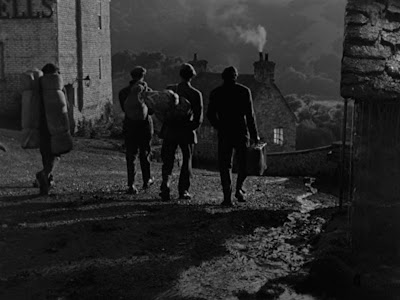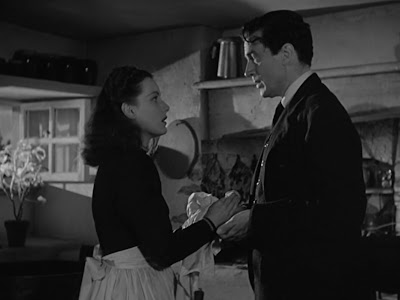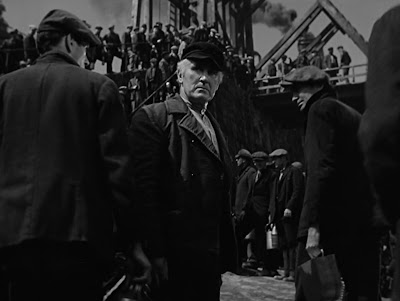 |
| The adult Morgan sons leave home. |
Release Date: Oct. 28, 1941. Running Time: 119 minutes. Screenplay: Philip Dunne. Based on the novel by: Richard Llewellyn. Producer: Darryl F. Zanuck. Director: John Ford.
THE PLOT:
The Morgans have lived all their lives in a Welsh village dominated a coal mine. Patriarch Gwilym Morgan (Donald Crisp) is the miners' spokesman. His adult sons are also miners - Ivor, Ianto, Davy, and Owen - while his youngest son, Huw (Roddy McDowall), is a schoolboy whose aptitude Gwilym hopes will lead him to a better life. Meanwhile, Gwilym's daughter, Angharad (Maureen O'Brien) harbors a not-so-secret crush on the young pastor, Mr. Gruffydd (Walter Pidgeon) - an attraction that is by no means unrequited.
The closure of a nearby ironworks leads to a wage reduction for the mine. Though Gwilym urges restraint, his sons join the bulk of the miners in calling for a strike. This event is a harbinger of increasing changes within the previously tight-knit community. As Gwilym's wife, Beth (Sara Allgood) mournfully observes: "This is only the beginning."
 |
| Angharad (Maureen O'Hara) and pastor Gruffydd (Walter Pidgeon) struggle with their mutual attraction. |
Mr. Gruffydd: The popular pastor is at least as practical as he is spiritual. When the pretentious deacon Mr. Parry (Arthur Shields) condemns the miners' union as "socialism," Gruffyd counters by supporting it: "Have your union. You need it... (but) you cannot conqer injustice with more injustice, only with justice." He assists the Morgans repeatedly, bringing Huw books after an accident leaves him bedridden, then pushing him to walk again once he recovers. Still, he lacks the courage to protest when Parry sadistically castigates a young unwed mother in front of the full parish. He also sends Angharad away rather than condemn her to a life of poverty with him - even though this act does not end up being a kindness to either of them.
Angharad Morgan: A very young Maureen O'Hara already shows her signature fire. When Gruffydd fails to speak up against Parry's treatment of the unwed mother, she does, even snapping at Gruffydd for his silence: "That is not the word of God... I know Meillyn Lewis is no worse than I am." Though Gruffydd avoids pursuing his attraction to her, she is less shy; after she receives a proposal from the mine owner's wealthy son, she confronts Gruffydd about their mutual feelings, vehement in her declaration that she wants to be with him rather than her suitor.
Gwilym Morgan: Donald Crisp won the Best Supporting Actor Oscar as the Morgan family patriarch. Crisp is wonderful, though I find myself wondering how Gwilym can be considered a supporting character. He's the real center of the film, a pragmatic but moral voice. He opposes the strike, stating that good workers are always worth good wages and that the owners are "men too, like us." Late in the film, after his sons have left to seek work elsewhere, he seems to have changed his mind, lamenting that in his day "there was good money and fair play for all" - an acknowledgement that this is no longer the case.
Beth Morgan: Sara Allgood is equally strong as Gwilym's wife. When the miners begin harassing her husband for his opposition to the strike, she goes out in the bitter snow to denounce them for it. She's a towering figure as she stands before them, shaking her fists as she vows that if any harm comes to her husband, she will "find out the men, and... kill them with (her) two hands!"
Huw Morgan: Child actor Roddy McDowall became a household name as Huw, the film's viewpoint character. It's easy to see why McDowall was so successful at such a young age: He is expressive but never too much so while reacting to surrounding events, whether watching the miners return to their homes after the strike is called or himself pushing a cart laden with coal through the dark mine.
 |
| Huw (Roddy McDowall) goes to work in the coal mine. |
THOUGHTS:
How Green Was My Valey is, at its core, a story about decline.
It opens with (too much) narration, the story being the recollections of the adult Huw. As he leaves the village for the last time, he recalls the valley as it was when he was a boy: "The waste of the coal pits had only begun... not yet enough to mar the countryside, nor blacken the beauty of our village."
One of the movie's five wins was for Arthur Miller's cinematography, and that award was well-deserved. The movie's first half features views of forest and open country surrounding the village... but even here, many shots include the smoke of the mine in the distance, a harbinger of things to come. By the final third, the village has gone from an open space to a closed and claustrophobic one, with every exterior shot dominated by thick smoke. The first half is mostly bright and well-lit; by the end, most shots are dark, and there is a sense of the sad, the grim, and the grimy hanging over the community - a village that has been ruined without its inhabitants ever fully noticing.
Though set in the late 19th century, the film is clearly informed by the Great Depression. This was released just one year after John Ford's film of The Grapes of Wrath, and the two films would make for an interesting double feature. In addition to the focus on unions, strikes, and workers' rights, we also see the dilemma caused by a nearby factory shutdown. There are now too many workers for the available jobs. Once the workers have been selected, the mine gates close, their bars resembling those of a prison - only the undesirable and unlucky are locked out instead of in. The Morgan sons complain about men standing in line for bread handed out by the government - something that would have been a common enough sight for contemporary filmgoers.
All this sounds like a grim slog, the kind of noble bore sometimes favored by Oscar voters. Thankfully, director John Ford keeps events bustling with energy and humor. The Morgans' house is constantly full of people, celebrating and arguing and drinking and being loudly, boisterously alive. Gwilym's front door is kept open, as if in invitation to his neighbors to drop by. The decline of the final third is marked as much by that door as by anything else: Suddenly, and for the first time in Huw's memory, it is shut tight.
The film has its faults. There are too many characters, and several of them disappear for extended periods. Events are episodic, and connections aren't always strong. The mine strike ends, presumably with a satisfactory result; but even as conditions decline, no one ever suggests attempting another strike. The final third makes much of a (mostly) baseless scandal involving Angharad and Mr. Gruffyd - but it comes after a solid thirty minutes that hasn't featured Angharad and has barely even mentioned her, which severely blunts its effectiveness. Meanwhile, too much time is given over to Huw's school woes... though I'll admit that I quite enjoyed a very John Ford scene in which an abusive English schoolteacher is given a polite but effective Welsh lesson in fisticuffs.
 |
| Gwilym (Donald Crisp) looks sadly back at the men shut out of the mine - including two of his sons. |
THE SNUBBING OF CITIZEN KANE
This was, of course, the movie that won Best Picture the year that Orson Welles' Citizen Kane was released. There's no question that Kane is the more important work, a film whose innovations pushed filmmaking forward. Even had its contemporary fortunes not been hobbled by William Randolph Hearst, however, I suspect How Green Was My Valley would have remained the more popular film in 1941. For all of Kane's brilliance, it's cold and, like many of Welles' pictures, doesn't really like people. Its defining image is of an old man, alone, reflected by mirrors. How Green Was My Valley brims with warmth, its defining image being a house full of singing, dancing, drinking, and life.
I fully agree that Citizen Kane is the greater film, and that the Academy voted wrong. Kane was snubbed - but that doesn't mean that How Green Was My Valley is anything less than a good film in its own right, and it is very far from being the least deserving Best Picture Winner.
REMAKES AND RETELLINGS:
How Green Was My Valley's episodic nature led to it being remade twice for British television, once in 1960 and again in 1975. The 1960 version, like too much 1960s television, is lost. The 1975 series, starring Stanley Baker and Siân Phillips, is widely available on DVD and is generally well-regarded.
 |
| The Valley, as it was before the mine spoiled it. |
OVERALL:
Though it suffers from an overabundance of characters, How Green Was My Valley is a well-crafted, highly engaging motion picture. Director John Ford keeps events moving and uses humor effectively to get viewers attached to the central family, and the visual composition of the shots is often beautiful - even when those visuals shift to mirror the story's darker turns in the late going.
Not quite a great film, in my opinion - but still a very good one, and well worth the two hours invested in watching it.
Overall Rating: 7/10.
Outstanding Production - 1940: Rebecca
Outstanding Motion Picture - 1942: Mrs. Miniver
Review Index
To receive new review updates, follow me:
On BlueSky:
On Threads:


No comments:
Post a Comment